Labour Pain - Is it really painful?
First things first ...
But trust me, you will see many women in the society who do not feel this pain as horrible as people make you feel. And yes, I am one of those who fought this notion positively.
Labor pain horrifies all the pregnant women out there. Thanks to all the Bollywood masalas, social media posts and many blogs that scare the hell out of us.
So many posts claim that Labor pain is equal to breaking 20 bones at a time or is more than what a human body could bare etc. Which is all not true.
What is labour pain?
" Labor pain = Physiological pain + Psychological pain "
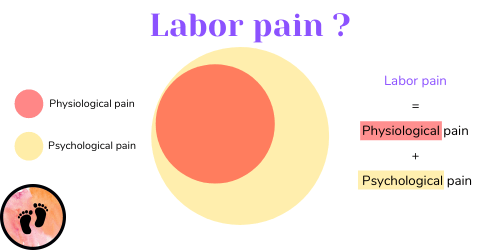 Labour is an emotional experience and involves both <b>physiological</b> and <b>psychological </b>mechanisms.
Labour is an emotional experience and involves both <b>physiological</b> and <b>psychological </b>mechanisms.Physiological Pain in Labor
Physiologically, the labour pain arises due to the contraction of uterus muscles and the pressure that is experienced by the cervix. The pain is experienced in the form of strong and intense menstrual cramps in groin, thighs, lower abdomen and back.
The intensity and endurance for the pain vary from pregnancy to pregnancy and woman to woman.
Psychological Pain in Labor
"No two-birth experience the same pain."
In a study of 300 pregnant women, labor pain study was conducted where they concluded that pain felt by different women was influenced by their emotional and psychological conditions. Education level was also one of the factors with contributed to more pain
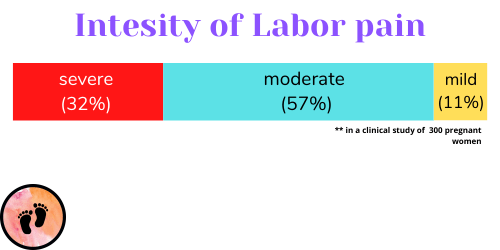 perception of pain felt by women is very subjective
perception of pain felt by women is very subjectiveFactors that can influence perception of Labor Pain (Psychological Pain)
- Cultural Beliefs
- Peer Pregnancy Stories
- Loneliness
- Expectations
- Fears
These factors can influence the intensity of perceived by the pregnant women. Setting these factors correctly can help you navigate easily through the labor pain.
Stages of Labour
The progression of labour is characterised into three stages:
- Stage 1: Early labour (1A) & Active labour (1B)
- Stage 2: Baby birth
- Stage 3: Placenta Delivery
- followed by recovery
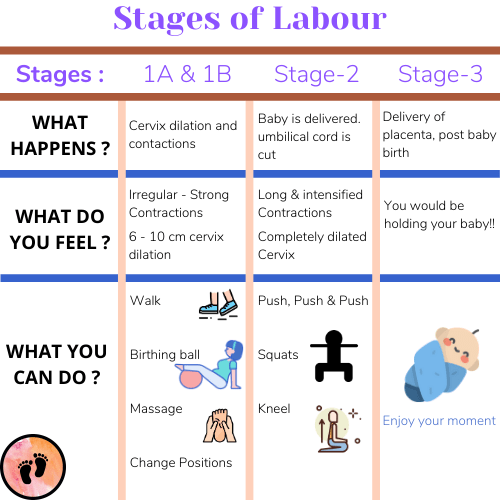 Stages of Labor - what to expect and what you could do during labor
Stages of Labor - what to expect and what you could do during laborStage 1:
First stage of labor involves thinning and dilation of cervix to help the baby move out
Stage 1 is again classified into 1A (early labor) and 2A (active labor)
Early Labor :
Usually Early labor is start to prepare for labor. You may start noticing initial contractions and decide to approach your health care provider for your delivery.
Your cervix would start to get thinner and dilate (up to 4 cm). You would need probably need to make your self comfortable and consume fluids. Take short walks and focus on breathing during contractions.
Active Labor :
In this phase your contractions would become regular and strong. Cervix dilation would reach to about 6-10cm.
In this phase your body would become completely ready for delivering your baby. Embrace your self by getting massage, short walks, birthing ball etc.
Stage -2
Here in this phase the cervix is completely open and Contractions are also at the peak. Your healthcare professional might ask you to push at regular intervals to ease the birthing. Different birthing techniques follow different approaches and might advise you differently.
Stage-3
In this phase your uterus contracts to push out the placenta. The placenta delivers usually after 5 to 15 minutes later.
Recovery
In this phase your body should recovery mode. If you are planning to breastfeed, then do it as soon as possible
Preparation for Labor
The preparation for labour beforehand is extremely important to have hassle-free childbirth. The preparation includes all ranging from bag pack to kind of delivery you want (medicated or non medicated).
Regular and light exercise (do not overdo) helps you to strengthen the muscles that will help you to elevate the endurance for your pain. Please consult your doctor before commencing any physical exercises and make sure you have risk free pregnancy.
Attend childbirth classes that prepare you for the lifetime experience by altering psychologically through Lamaze technique and Bradley method
Lamaze technique
This learning coaches the woman that “Birth is a natural and a very normal process” and encourages woman to go with medication-free delivery with confidence and strength.
all these form an integral part of this coaching.
Bradley method
This coaching mentors the husbands for the childbirth and encourages their active participation throughout the process. This training also prepares for emergency situations and how the couple should take the right decisions for the same.
Pain Management during Labour
The child birthing process involves pain. Pregnant women have options to take when is come to overcome this pain.
A good & prior preparation can prevent an overwhelming painful experience.
Also being aware about all the options available can help you make a suitable decision.
Pain during Labor can be managed using the below approaches :
- Medication Pain Management
- Non-Medicated Pain Management
1. Medicated Pain Management
 Medicated labor pain management options for pregnant women
Medicated labor pain management options for pregnant womenSYSTEMIC ANALGESICS FOR PAIN RELIEF IN LABOR:
Intra-venous or Intra-Muscular injections are administered in this method. This medicine acts on your entire nervous system instead of regional/ local area.
Pros :
- Cheap treatment
- Do not need sophisticated medical equipment.
Cons :
- Not very effective in pain relief, patients usually experience pain even after taking these medications
- Injected opioids may cause drowsiness and interfere in decision making abilities
- nausea & vomiting are also common side effects
- Opioids can cause fetal heart rate variations during labour.
- Infant also can have these medicines in his/her system, & may take a while to remove them completely
INHALATIONAL AGENTS / NITROUS OXIDE DURING LABOR :
In high concentrations nitrous oxide is a weak anaesthetic. In low doses, it is an anxiolytic agent and also acts as analgesic agent.
A blend of equal ratio oxygen : nitrous oxide is used as pain relief agent during labor.
Pros :
- Does not interfere in physiology and labor progress. Deemed safe by most Midwifery associations
- Infant alertness is not affected
- Does not effect breastfeeding
- Pregnant women can stay alert
Cons :
- May cause sedation
- Dizziness, Nausea & Vomiting may be noticed
SPINAL & EPIDURAL BLOCKS
Epidural and spinal-epidural blocks are the most popular ones. They come under regional anaesthesia
Epidural Injections for labor:
Action : It interferes with nerve impulses and blocks their propagation, thus reducing the intensity of pain. It blocks pain from an entire region of the body, such as the belly, the hips, the legs, or the pelvis.
Possible side effects : Drop in blood pressure, Breathing problems, Nausea, Immobility for few hours post delivery
Spinal Block during labor:
Action : A type of regional anaesthesia, given in spine. This acts quickly and lasts for about 2 hrs. Usually given during c-section.
Possible side effects : Drowsiness, Nausea, Tingling sensation, Numbness
Differences between Epidural and Spinal Anaesthesia
Spinal Epidural Block for labor:
Action : An immediate anaesthetic action along with longterm control is achieved using this combination of epidural block with spinal injection.
PUDENDAL & PARACERVICAL BLOCKS FOR LABOR PAIN MANAGEMENT:
Pudendal block
Pudendal block helps to relieve the pain in second stage of labor (during the push phase) and is administered through the vaginal wall and into the pudendal nerve in the pelvis, numbing the area between the vagina and anus (perineum).
Pudendal blocks do not relieve the pain of contractions.
Pros : A pudendal block works quickly, is easily administered, and does not affect the baby. It is given shortly before delivery.
Cons : But it cannot be used if the baby's head is too far down in the birth canal (vagina).
Paracervical block
Paracervical block is a local anaesthetic agent which acts for around 1-2 hrs. It reduces the pain caused by contractions and stretching of the cervix.
Sometimes the baby's heartbeat can slow down after a paracervical block is done. Paracervical blocks are rarely done today, because epidural anaesthesia is more effective.
2. Non-Medicated Pain Management
Take the help of the health provider to understand the pros and cons of pain management techniques. Also, he will be the best to tell you which one will work best for you as he knows your progression.
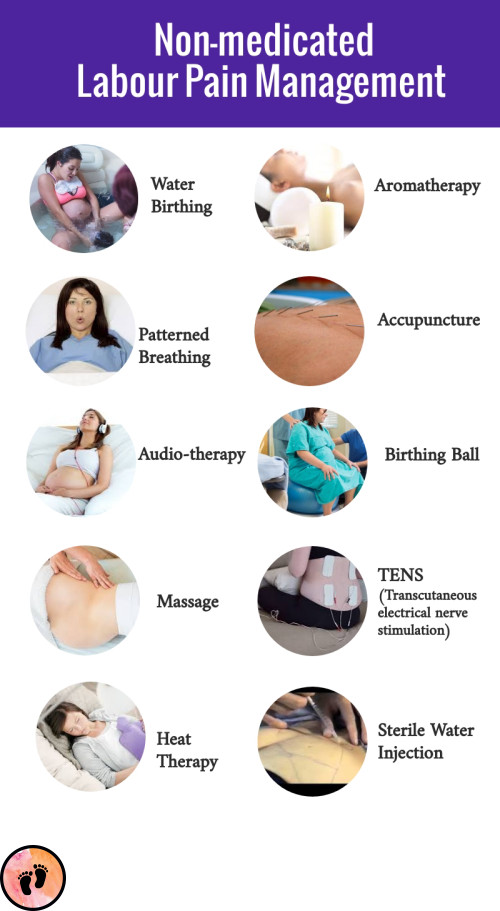 Non-medicated techniques for pain Management during labour
Non-medicated techniques for pain Management during labourTrust me, you will forget all the pain that you have gone through in just a second when those tiny little souls will be kept on you. The eyes of that little one will definitely speak how brave you are to bring him or her in this beautiful world.
References



More Information
Below infographics shows the summary of all the phases, symptoms in respective phases, duration of each phase and management in each phaseOther
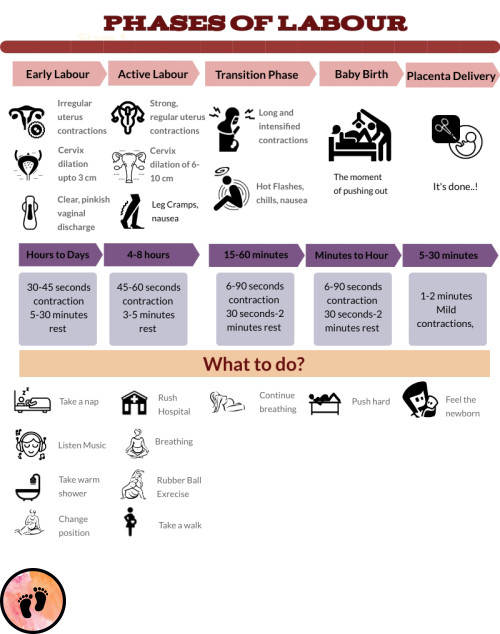 Stages of labour and its duration along with management techniques
Stages of labour and its duration along with management techniques Medicated pain management techniques and side-effects associated with them
Medicated pain management techniques and side-effects associated with themRecent Posts
Homemade Pregnancy Test
How to Prevent Pregnancy Stretch Marks
Is It Safe to Eat Ice Cream During Pregnancy
Breast Pain in Pregnancy
7 Tips to getting pregnant faster
COMMON INFECTIONS DURING PREGNANCY
Pregnancy Diet: Apples during Pregnancy
Advertisement
Duis leo. Donec orci lectus, aliquam ut, faucibus non
Join Our Community of Expecting Parents Today!
Subscribe to get updated on latest and relevant pregnancy-related details